Developing Business Strategy for Woolworths: PRJM6005 Report
VerifiedAdded on 2023/05/28
|16
|4772
|58
Report
AI Summary
This report presents a comprehensive business strategy analysis for Woolworths, focusing on its organizational context, external and internal environments, and strategic recommendations. Part A establishes Woolworths' strategic intent, positioning statement, and industrial value chain. Part B1 employs Porter's Five Forces and PESTLE analysis to assess the external environment, identifying key competitive forces and macro-environmental factors influencing the company. Part B2 utilizes the firm value chain to analyze Woolworths' internal capabilities and value-creating activities. Part C synthesizes the findings through a SWOT analysis, highlighting strengths, weaknesses, opportunities, and threats. Finally, Part D provides actionable recommendations for Woolworths to improve its performance over the next four years, addressing key challenges and leveraging opportunities identified in the analysis.
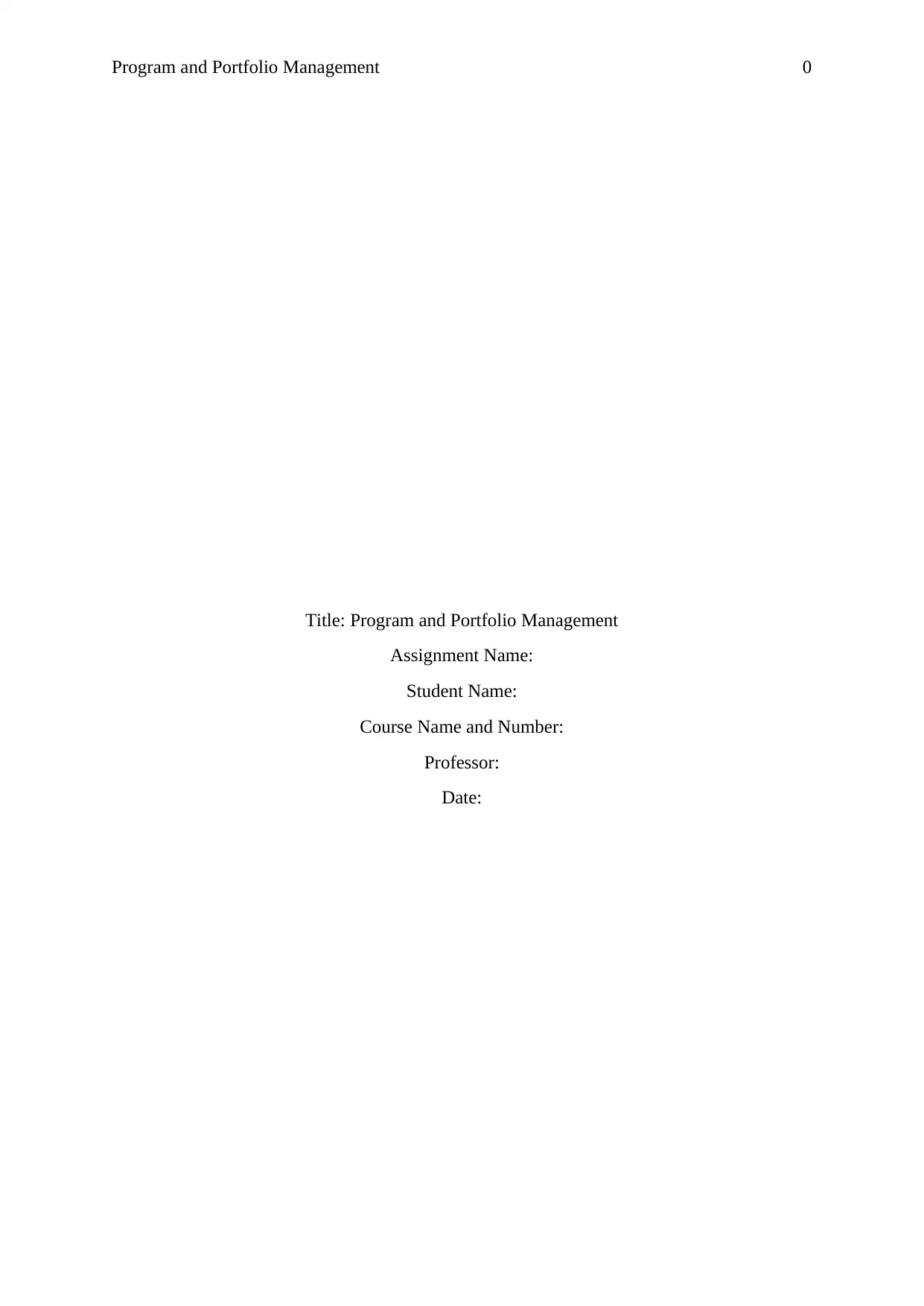
Program and Portfolio Management 0
Title: Program and Portfolio Management
Assignment Name:
Student Name:
Course Name and Number:
Professor:
Date:
Title: Program and Portfolio Management
Assignment Name:
Student Name:
Course Name and Number:
Professor:
Date:
Paraphrase This Document
Need a fresh take? Get an instant paraphrase of this document with our AI Paraphraser
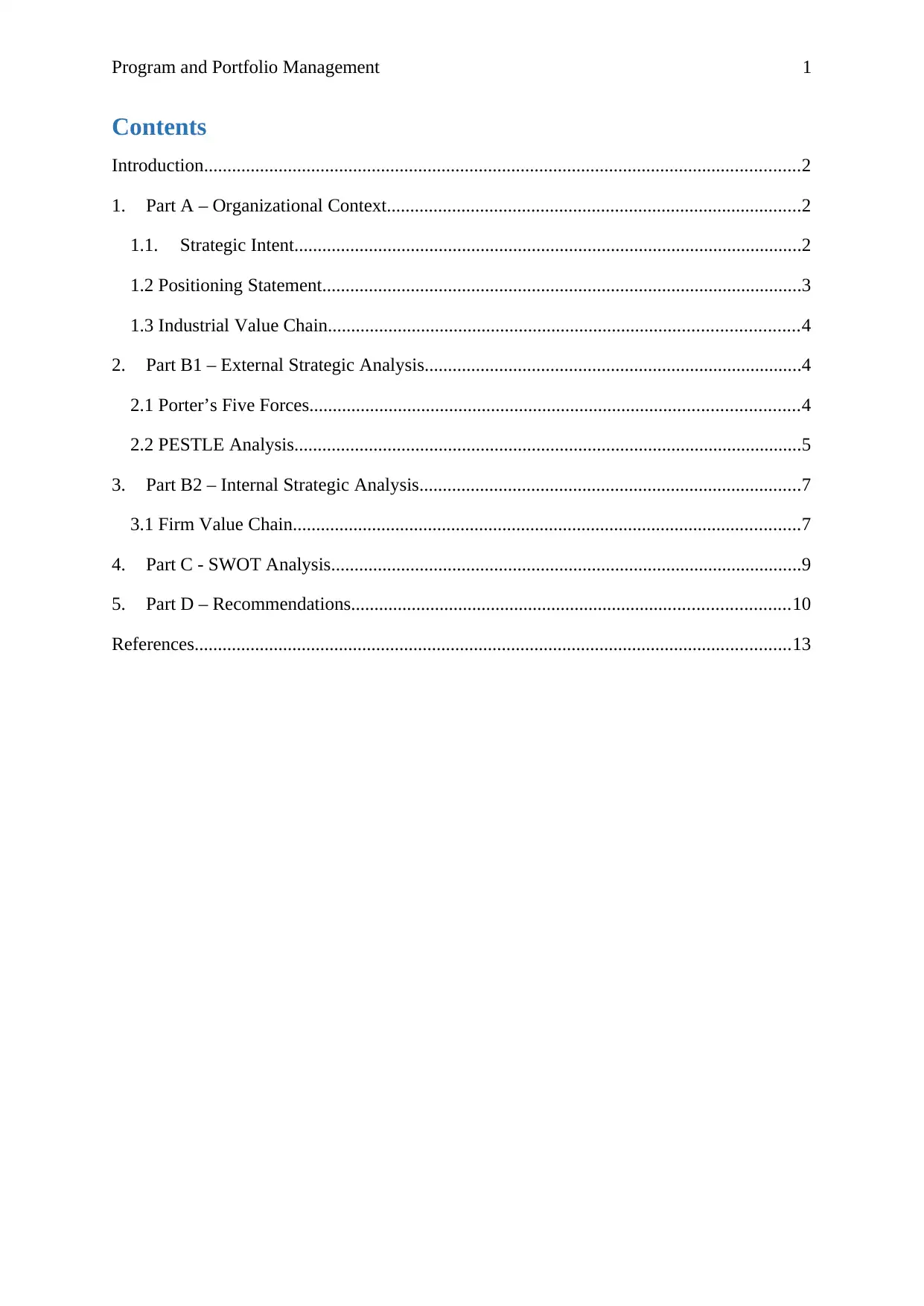
Program and Portfolio Management 1
Contents
Introduction................................................................................................................................2
1. Part A – Organizational Context.........................................................................................2
1.1. Strategic Intent.............................................................................................................2
1.2 Positioning Statement.......................................................................................................3
1.3 Industrial Value Chain.....................................................................................................4
2. Part B1 – External Strategic Analysis.................................................................................4
2.1 Porter’s Five Forces.........................................................................................................4
2.2 PESTLE Analysis.............................................................................................................5
3. Part B2 – Internal Strategic Analysis..................................................................................7
3.1 Firm Value Chain.............................................................................................................7
4. Part C - SWOT Analysis.....................................................................................................9
5. Part D – Recommendations..............................................................................................10
References................................................................................................................................13
Contents
Introduction................................................................................................................................2
1. Part A – Organizational Context.........................................................................................2
1.1. Strategic Intent.............................................................................................................2
1.2 Positioning Statement.......................................................................................................3
1.3 Industrial Value Chain.....................................................................................................4
2. Part B1 – External Strategic Analysis.................................................................................4
2.1 Porter’s Five Forces.........................................................................................................4
2.2 PESTLE Analysis.............................................................................................................5
3. Part B2 – Internal Strategic Analysis..................................................................................7
3.1 Firm Value Chain.............................................................................................................7
4. Part C - SWOT Analysis.....................................................................................................9
5. Part D – Recommendations..............................................................................................10
References................................................................................................................................13
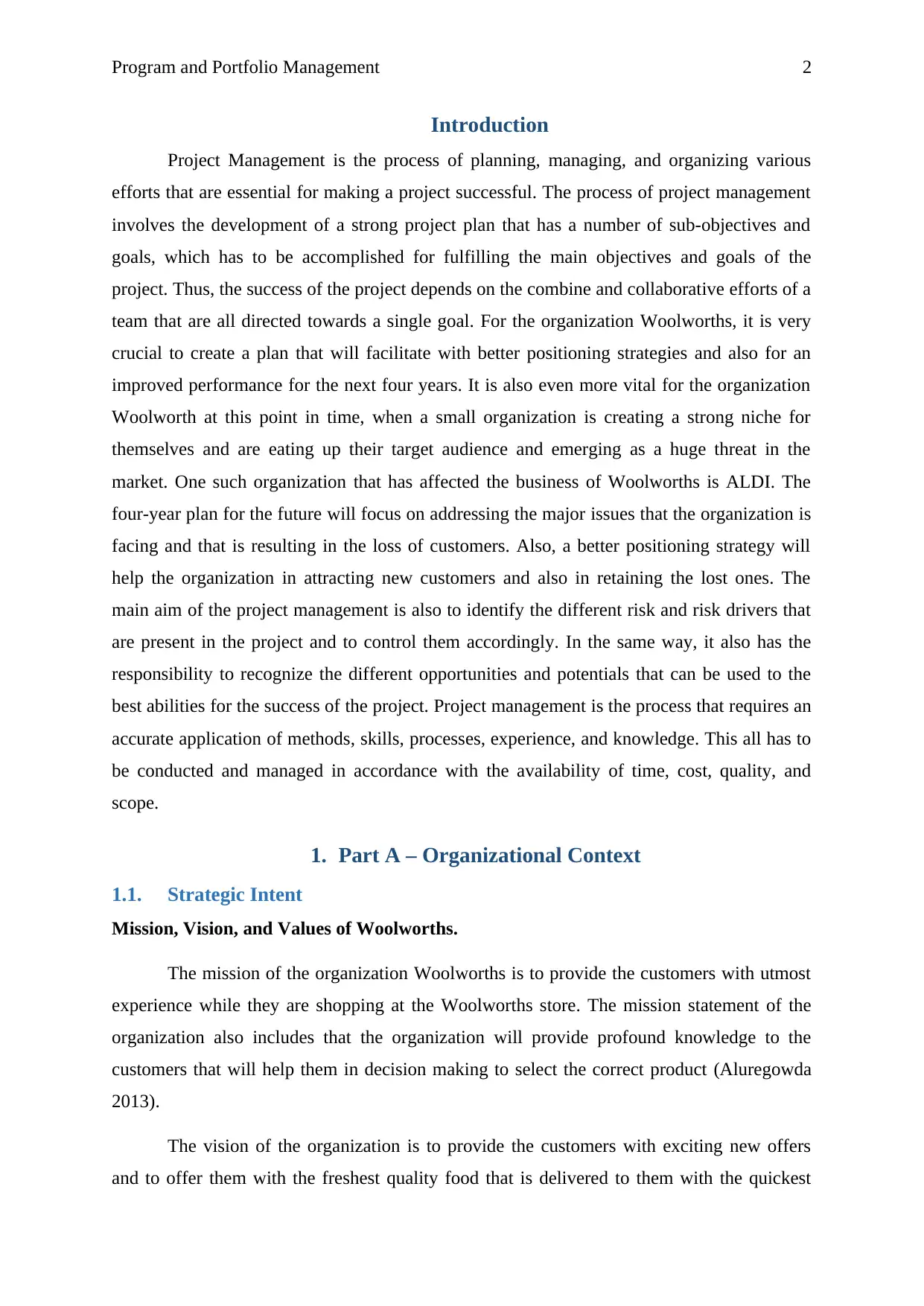
Program and Portfolio Management 2
Introduction
Project Management is the process of planning, managing, and organizing various
efforts that are essential for making a project successful. The process of project management
involves the development of a strong project plan that has a number of sub-objectives and
goals, which has to be accomplished for fulfilling the main objectives and goals of the
project. Thus, the success of the project depends on the combine and collaborative efforts of a
team that are all directed towards a single goal. For the organization Woolworths, it is very
crucial to create a plan that will facilitate with better positioning strategies and also for an
improved performance for the next four years. It is also even more vital for the organization
Woolworth at this point in time, when a small organization is creating a strong niche for
themselves and are eating up their target audience and emerging as a huge threat in the
market. One such organization that has affected the business of Woolworths is ALDI. The
four-year plan for the future will focus on addressing the major issues that the organization is
facing and that is resulting in the loss of customers. Also, a better positioning strategy will
help the organization in attracting new customers and also in retaining the lost ones. The
main aim of the project management is also to identify the different risk and risk drivers that
are present in the project and to control them accordingly. In the same way, it also has the
responsibility to recognize the different opportunities and potentials that can be used to the
best abilities for the success of the project. Project management is the process that requires an
accurate application of methods, skills, processes, experience, and knowledge. This all has to
be conducted and managed in accordance with the availability of time, cost, quality, and
scope.
1. Part A – Organizational Context
1.1. Strategic Intent
Mission, Vision, and Values of Woolworths.
The mission of the organization Woolworths is to provide the customers with utmost
experience while they are shopping at the Woolworths store. The mission statement of the
organization also includes that the organization will provide profound knowledge to the
customers that will help them in decision making to select the correct product (Aluregowda
2013).
The vision of the organization is to provide the customers with exciting new offers
and to offer them with the freshest quality food that is delivered to them with the quickest
Introduction
Project Management is the process of planning, managing, and organizing various
efforts that are essential for making a project successful. The process of project management
involves the development of a strong project plan that has a number of sub-objectives and
goals, which has to be accomplished for fulfilling the main objectives and goals of the
project. Thus, the success of the project depends on the combine and collaborative efforts of a
team that are all directed towards a single goal. For the organization Woolworths, it is very
crucial to create a plan that will facilitate with better positioning strategies and also for an
improved performance for the next four years. It is also even more vital for the organization
Woolworth at this point in time, when a small organization is creating a strong niche for
themselves and are eating up their target audience and emerging as a huge threat in the
market. One such organization that has affected the business of Woolworths is ALDI. The
four-year plan for the future will focus on addressing the major issues that the organization is
facing and that is resulting in the loss of customers. Also, a better positioning strategy will
help the organization in attracting new customers and also in retaining the lost ones. The
main aim of the project management is also to identify the different risk and risk drivers that
are present in the project and to control them accordingly. In the same way, it also has the
responsibility to recognize the different opportunities and potentials that can be used to the
best abilities for the success of the project. Project management is the process that requires an
accurate application of methods, skills, processes, experience, and knowledge. This all has to
be conducted and managed in accordance with the availability of time, cost, quality, and
scope.
1. Part A – Organizational Context
1.1. Strategic Intent
Mission, Vision, and Values of Woolworths.
The mission of the organization Woolworths is to provide the customers with utmost
experience while they are shopping at the Woolworths store. The mission statement of the
organization also includes that the organization will provide profound knowledge to the
customers that will help them in decision making to select the correct product (Aluregowda
2013).
The vision of the organization is to provide the customers with exciting new offers
and to offer them with the freshest quality food that is delivered to them with the quickest
⊘ This is a preview!⊘
Do you want full access?
Subscribe today to unlock all pages.

Trusted by 1+ million students worldwide
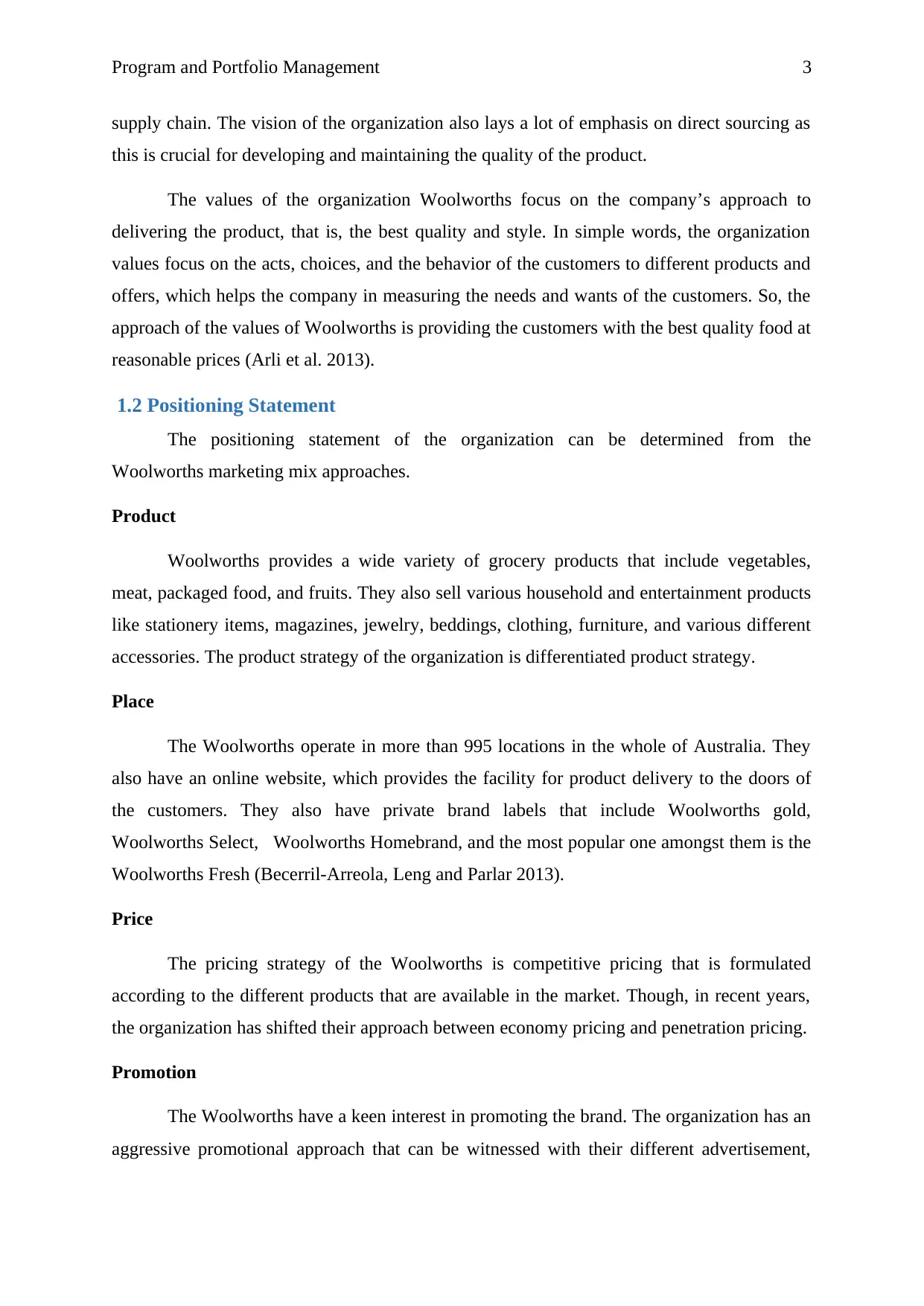
Program and Portfolio Management 3
supply chain. The vision of the organization also lays a lot of emphasis on direct sourcing as
this is crucial for developing and maintaining the quality of the product.
The values of the organization Woolworths focus on the company’s approach to
delivering the product, that is, the best quality and style. In simple words, the organization
values focus on the acts, choices, and the behavior of the customers to different products and
offers, which helps the company in measuring the needs and wants of the customers. So, the
approach of the values of Woolworths is providing the customers with the best quality food at
reasonable prices (Arli et al. 2013).
1.2 Positioning Statement
The positioning statement of the organization can be determined from the
Woolworths marketing mix approaches.
Product
Woolworths provides a wide variety of grocery products that include vegetables,
meat, packaged food, and fruits. They also sell various household and entertainment products
like stationery items, magazines, jewelry, beddings, clothing, furniture, and various different
accessories. The product strategy of the organization is differentiated product strategy.
Place
The Woolworths operate in more than 995 locations in the whole of Australia. They
also have an online website, which provides the facility for product delivery to the doors of
the customers. They also have private brand labels that include Woolworths gold,
Woolworths Select, Woolworths Homebrand, and the most popular one amongst them is the
Woolworths Fresh (Becerril-Arreola, Leng and Parlar 2013).
Price
The pricing strategy of the Woolworths is competitive pricing that is formulated
according to the different products that are available in the market. Though, in recent years,
the organization has shifted their approach between economy pricing and penetration pricing.
Promotion
The Woolworths have a keen interest in promoting the brand. The organization has an
aggressive promotional approach that can be witnessed with their different advertisement,
supply chain. The vision of the organization also lays a lot of emphasis on direct sourcing as
this is crucial for developing and maintaining the quality of the product.
The values of the organization Woolworths focus on the company’s approach to
delivering the product, that is, the best quality and style. In simple words, the organization
values focus on the acts, choices, and the behavior of the customers to different products and
offers, which helps the company in measuring the needs and wants of the customers. So, the
approach of the values of Woolworths is providing the customers with the best quality food at
reasonable prices (Arli et al. 2013).
1.2 Positioning Statement
The positioning statement of the organization can be determined from the
Woolworths marketing mix approaches.
Product
Woolworths provides a wide variety of grocery products that include vegetables,
meat, packaged food, and fruits. They also sell various household and entertainment products
like stationery items, magazines, jewelry, beddings, clothing, furniture, and various different
accessories. The product strategy of the organization is differentiated product strategy.
Place
The Woolworths operate in more than 995 locations in the whole of Australia. They
also have an online website, which provides the facility for product delivery to the doors of
the customers. They also have private brand labels that include Woolworths gold,
Woolworths Select, Woolworths Homebrand, and the most popular one amongst them is the
Woolworths Fresh (Becerril-Arreola, Leng and Parlar 2013).
Price
The pricing strategy of the Woolworths is competitive pricing that is formulated
according to the different products that are available in the market. Though, in recent years,
the organization has shifted their approach between economy pricing and penetration pricing.
Promotion
The Woolworths have a keen interest in promoting the brand. The organization has an
aggressive promotional approach that can be witnessed with their different advertisement,
Paraphrase This Document
Need a fresh take? Get an instant paraphrase of this document with our AI Paraphraser
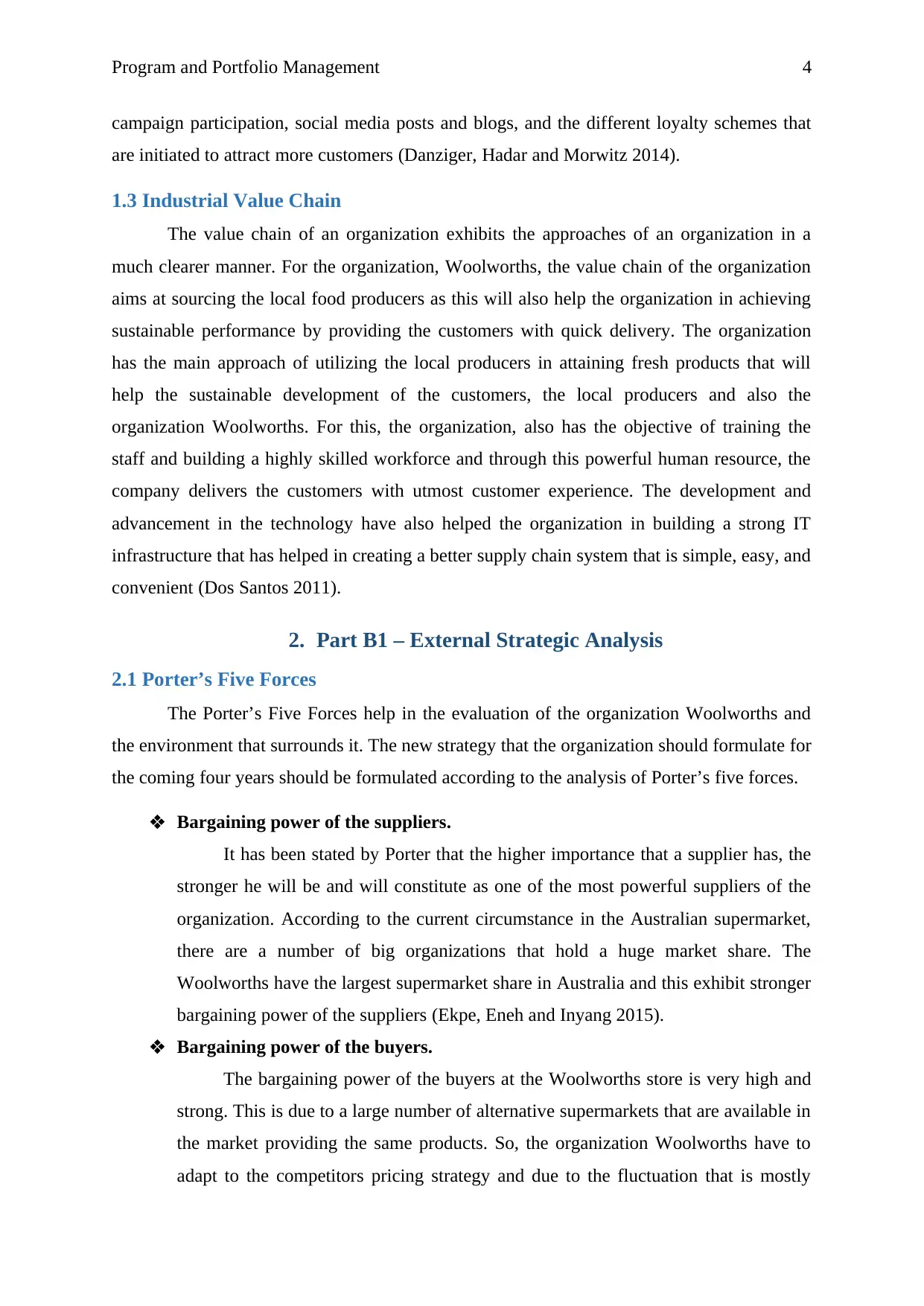
Program and Portfolio Management 4
campaign participation, social media posts and blogs, and the different loyalty schemes that
are initiated to attract more customers (Danziger, Hadar and Morwitz 2014).
1.3 Industrial Value Chain
The value chain of an organization exhibits the approaches of an organization in a
much clearer manner. For the organization, Woolworths, the value chain of the organization
aims at sourcing the local food producers as this will also help the organization in achieving
sustainable performance by providing the customers with quick delivery. The organization
has the main approach of utilizing the local producers in attaining fresh products that will
help the sustainable development of the customers, the local producers and also the
organization Woolworths. For this, the organization, also has the objective of training the
staff and building a highly skilled workforce and through this powerful human resource, the
company delivers the customers with utmost customer experience. The development and
advancement in the technology have also helped the organization in building a strong IT
infrastructure that has helped in creating a better supply chain system that is simple, easy, and
convenient (Dos Santos 2011).
2. Part B1 – External Strategic Analysis
2.1 Porter’s Five Forces
The Porter’s Five Forces help in the evaluation of the organization Woolworths and
the environment that surrounds it. The new strategy that the organization should formulate for
the coming four years should be formulated according to the analysis of Porter’s five forces.
Bargaining power of the suppliers.
It has been stated by Porter that the higher importance that a supplier has, the
stronger he will be and will constitute as one of the most powerful suppliers of the
organization. According to the current circumstance in the Australian supermarket,
there are a number of big organizations that hold a huge market share. The
Woolworths have the largest supermarket share in Australia and this exhibit stronger
bargaining power of the suppliers (Ekpe, Eneh and Inyang 2015).
Bargaining power of the buyers.
The bargaining power of the buyers at the Woolworths store is very high and
strong. This is due to a large number of alternative supermarkets that are available in
the market providing the same products. So, the organization Woolworths have to
adapt to the competitors pricing strategy and due to the fluctuation that is mostly
campaign participation, social media posts and blogs, and the different loyalty schemes that
are initiated to attract more customers (Danziger, Hadar and Morwitz 2014).
1.3 Industrial Value Chain
The value chain of an organization exhibits the approaches of an organization in a
much clearer manner. For the organization, Woolworths, the value chain of the organization
aims at sourcing the local food producers as this will also help the organization in achieving
sustainable performance by providing the customers with quick delivery. The organization
has the main approach of utilizing the local producers in attaining fresh products that will
help the sustainable development of the customers, the local producers and also the
organization Woolworths. For this, the organization, also has the objective of training the
staff and building a highly skilled workforce and through this powerful human resource, the
company delivers the customers with utmost customer experience. The development and
advancement in the technology have also helped the organization in building a strong IT
infrastructure that has helped in creating a better supply chain system that is simple, easy, and
convenient (Dos Santos 2011).
2. Part B1 – External Strategic Analysis
2.1 Porter’s Five Forces
The Porter’s Five Forces help in the evaluation of the organization Woolworths and
the environment that surrounds it. The new strategy that the organization should formulate for
the coming four years should be formulated according to the analysis of Porter’s five forces.
Bargaining power of the suppliers.
It has been stated by Porter that the higher importance that a supplier has, the
stronger he will be and will constitute as one of the most powerful suppliers of the
organization. According to the current circumstance in the Australian supermarket,
there are a number of big organizations that hold a huge market share. The
Woolworths have the largest supermarket share in Australia and this exhibit stronger
bargaining power of the suppliers (Ekpe, Eneh and Inyang 2015).
Bargaining power of the buyers.
The bargaining power of the buyers at the Woolworths store is very high and
strong. This is due to a large number of alternative supermarkets that are available in
the market providing the same products. So, the organization Woolworths have to
adapt to the competitors pricing strategy and due to the fluctuation that is mostly
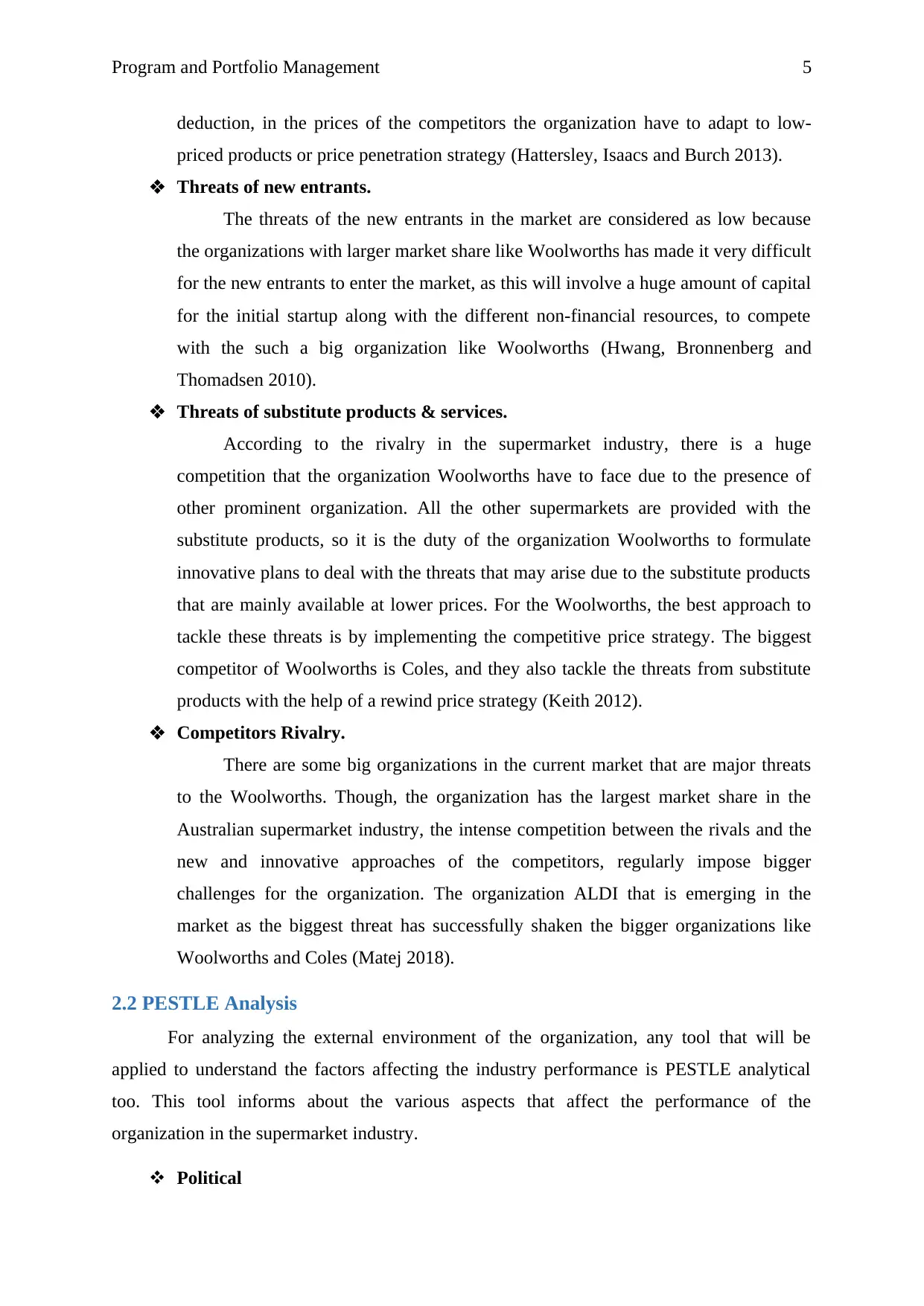
Program and Portfolio Management 5
deduction, in the prices of the competitors the organization have to adapt to low-
priced products or price penetration strategy (Hattersley, Isaacs and Burch 2013).
Threats of new entrants.
The threats of the new entrants in the market are considered as low because
the organizations with larger market share like Woolworths has made it very difficult
for the new entrants to enter the market, as this will involve a huge amount of capital
for the initial startup along with the different non-financial resources, to compete
with the such a big organization like Woolworths (Hwang, Bronnenberg and
Thomadsen 2010).
Threats of substitute products & services.
According to the rivalry in the supermarket industry, there is a huge
competition that the organization Woolworths have to face due to the presence of
other prominent organization. All the other supermarkets are provided with the
substitute products, so it is the duty of the organization Woolworths to formulate
innovative plans to deal with the threats that may arise due to the substitute products
that are mainly available at lower prices. For the Woolworths, the best approach to
tackle these threats is by implementing the competitive price strategy. The biggest
competitor of Woolworths is Coles, and they also tackle the threats from substitute
products with the help of a rewind price strategy (Keith 2012).
Competitors Rivalry.
There are some big organizations in the current market that are major threats
to the Woolworths. Though, the organization has the largest market share in the
Australian supermarket industry, the intense competition between the rivals and the
new and innovative approaches of the competitors, regularly impose bigger
challenges for the organization. The organization ALDI that is emerging in the
market as the biggest threat has successfully shaken the bigger organizations like
Woolworths and Coles (Matej 2018).
2.2 PESTLE Analysis
For analyzing the external environment of the organization, any tool that will be
applied to understand the factors affecting the industry performance is PESTLE analytical
too. This tool informs about the various aspects that affect the performance of the
organization in the supermarket industry.
Political
deduction, in the prices of the competitors the organization have to adapt to low-
priced products or price penetration strategy (Hattersley, Isaacs and Burch 2013).
Threats of new entrants.
The threats of the new entrants in the market are considered as low because
the organizations with larger market share like Woolworths has made it very difficult
for the new entrants to enter the market, as this will involve a huge amount of capital
for the initial startup along with the different non-financial resources, to compete
with the such a big organization like Woolworths (Hwang, Bronnenberg and
Thomadsen 2010).
Threats of substitute products & services.
According to the rivalry in the supermarket industry, there is a huge
competition that the organization Woolworths have to face due to the presence of
other prominent organization. All the other supermarkets are provided with the
substitute products, so it is the duty of the organization Woolworths to formulate
innovative plans to deal with the threats that may arise due to the substitute products
that are mainly available at lower prices. For the Woolworths, the best approach to
tackle these threats is by implementing the competitive price strategy. The biggest
competitor of Woolworths is Coles, and they also tackle the threats from substitute
products with the help of a rewind price strategy (Keith 2012).
Competitors Rivalry.
There are some big organizations in the current market that are major threats
to the Woolworths. Though, the organization has the largest market share in the
Australian supermarket industry, the intense competition between the rivals and the
new and innovative approaches of the competitors, regularly impose bigger
challenges for the organization. The organization ALDI that is emerging in the
market as the biggest threat has successfully shaken the bigger organizations like
Woolworths and Coles (Matej 2018).
2.2 PESTLE Analysis
For analyzing the external environment of the organization, any tool that will be
applied to understand the factors affecting the industry performance is PESTLE analytical
too. This tool informs about the various aspects that affect the performance of the
organization in the supermarket industry.
Political
⊘ This is a preview!⊘
Do you want full access?
Subscribe today to unlock all pages.

Trusted by 1+ million students worldwide
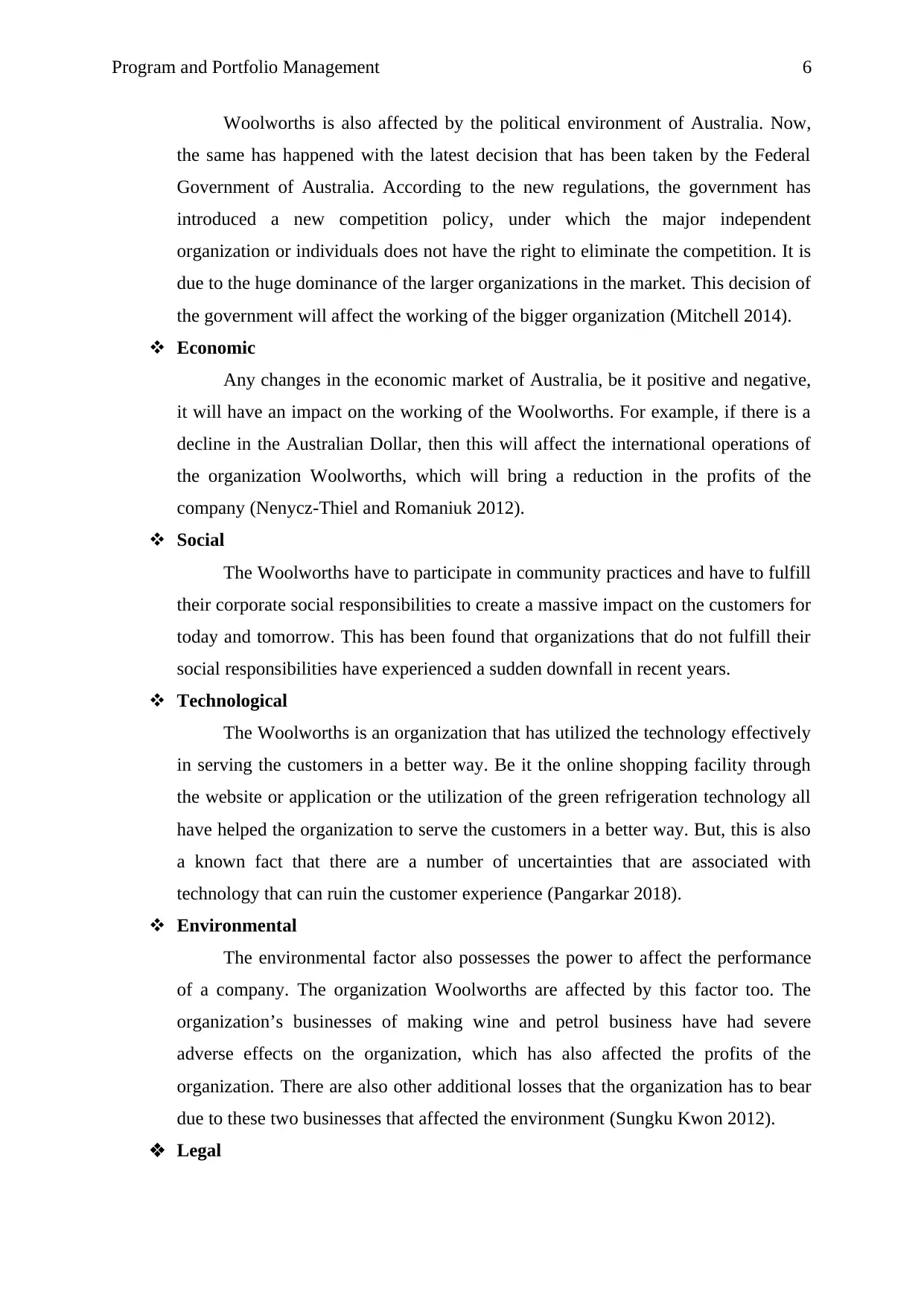
Program and Portfolio Management 6
Woolworths is also affected by the political environment of Australia. Now,
the same has happened with the latest decision that has been taken by the Federal
Government of Australia. According to the new regulations, the government has
introduced a new competition policy, under which the major independent
organization or individuals does not have the right to eliminate the competition. It is
due to the huge dominance of the larger organizations in the market. This decision of
the government will affect the working of the bigger organization (Mitchell 2014).
Economic
Any changes in the economic market of Australia, be it positive and negative,
it will have an impact on the working of the Woolworths. For example, if there is a
decline in the Australian Dollar, then this will affect the international operations of
the organization Woolworths, which will bring a reduction in the profits of the
company (Nenycz-Thiel and Romaniuk 2012).
Social
The Woolworths have to participate in community practices and have to fulfill
their corporate social responsibilities to create a massive impact on the customers for
today and tomorrow. This has been found that organizations that do not fulfill their
social responsibilities have experienced a sudden downfall in recent years.
Technological
The Woolworths is an organization that has utilized the technology effectively
in serving the customers in a better way. Be it the online shopping facility through
the website or application or the utilization of the green refrigeration technology all
have helped the organization to serve the customers in a better way. But, this is also
a known fact that there are a number of uncertainties that are associated with
technology that can ruin the customer experience (Pangarkar 2018).
Environmental
The environmental factor also possesses the power to affect the performance
of a company. The organization Woolworths are affected by this factor too. The
organization’s businesses of making wine and petrol business have had severe
adverse effects on the organization, which has also affected the profits of the
organization. There are also other additional losses that the organization has to bear
due to these two businesses that affected the environment (Sungku Kwon 2012).
Legal
Woolworths is also affected by the political environment of Australia. Now,
the same has happened with the latest decision that has been taken by the Federal
Government of Australia. According to the new regulations, the government has
introduced a new competition policy, under which the major independent
organization or individuals does not have the right to eliminate the competition. It is
due to the huge dominance of the larger organizations in the market. This decision of
the government will affect the working of the bigger organization (Mitchell 2014).
Economic
Any changes in the economic market of Australia, be it positive and negative,
it will have an impact on the working of the Woolworths. For example, if there is a
decline in the Australian Dollar, then this will affect the international operations of
the organization Woolworths, which will bring a reduction in the profits of the
company (Nenycz-Thiel and Romaniuk 2012).
Social
The Woolworths have to participate in community practices and have to fulfill
their corporate social responsibilities to create a massive impact on the customers for
today and tomorrow. This has been found that organizations that do not fulfill their
social responsibilities have experienced a sudden downfall in recent years.
Technological
The Woolworths is an organization that has utilized the technology effectively
in serving the customers in a better way. Be it the online shopping facility through
the website or application or the utilization of the green refrigeration technology all
have helped the organization to serve the customers in a better way. But, this is also
a known fact that there are a number of uncertainties that are associated with
technology that can ruin the customer experience (Pangarkar 2018).
Environmental
The environmental factor also possesses the power to affect the performance
of a company. The organization Woolworths are affected by this factor too. The
organization’s businesses of making wine and petrol business have had severe
adverse effects on the organization, which has also affected the profits of the
organization. There are also other additional losses that the organization has to bear
due to these two businesses that affected the environment (Sungku Kwon 2012).
Legal
Paraphrase This Document
Need a fresh take? Get an instant paraphrase of this document with our AI Paraphraser
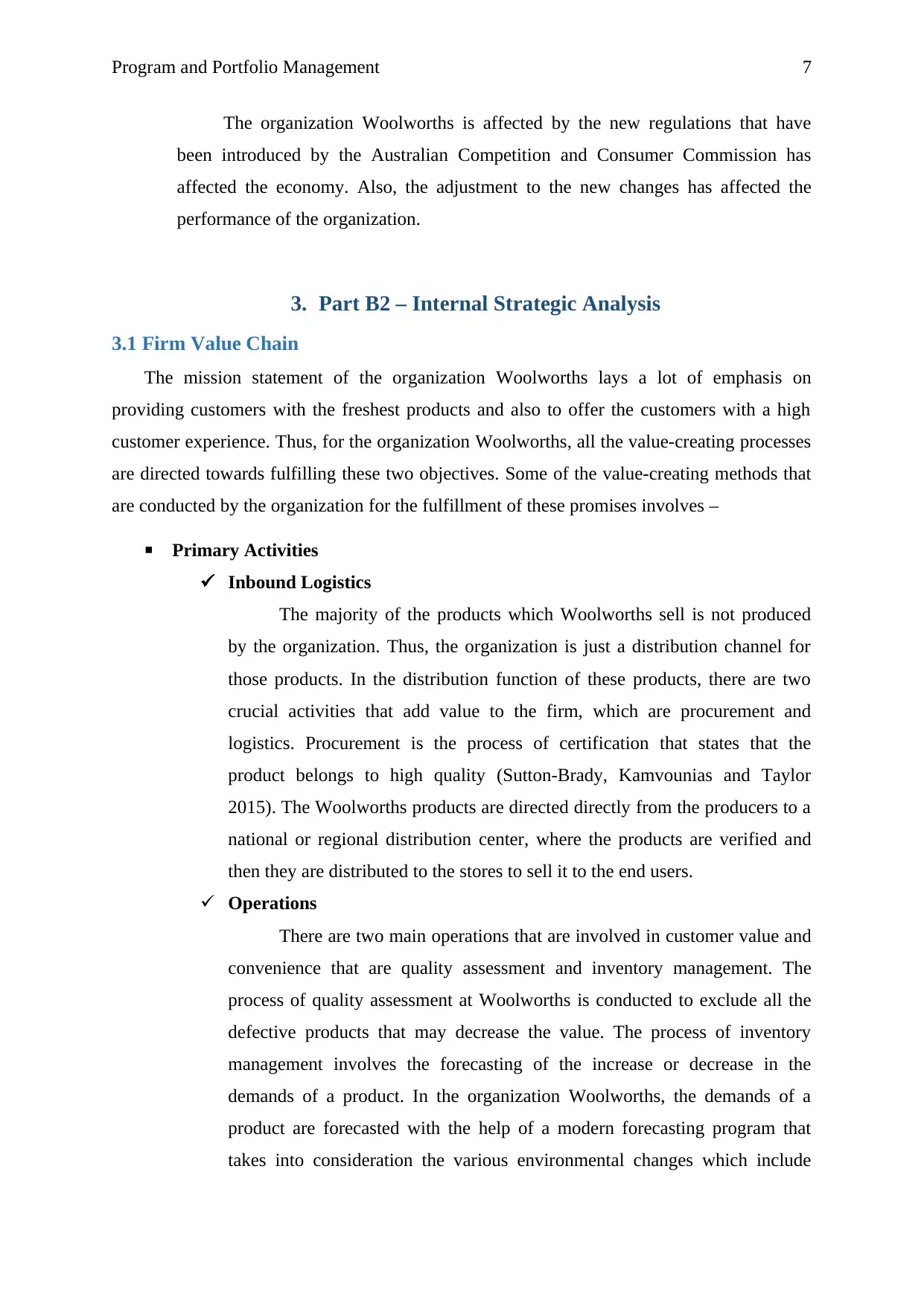
Program and Portfolio Management 7
The organization Woolworths is affected by the new regulations that have
been introduced by the Australian Competition and Consumer Commission has
affected the economy. Also, the adjustment to the new changes has affected the
performance of the organization.
3. Part B2 – Internal Strategic Analysis
3.1 Firm Value Chain
The mission statement of the organization Woolworths lays a lot of emphasis on
providing customers with the freshest products and also to offer the customers with a high
customer experience. Thus, for the organization Woolworths, all the value-creating processes
are directed towards fulfilling these two objectives. Some of the value-creating methods that
are conducted by the organization for the fulfillment of these promises involves –
Primary Activities
Inbound Logistics
The majority of the products which Woolworths sell is not produced
by the organization. Thus, the organization is just a distribution channel for
those products. In the distribution function of these products, there are two
crucial activities that add value to the firm, which are procurement and
logistics. Procurement is the process of certification that states that the
product belongs to high quality (Sutton-Brady, Kamvounias and Taylor
2015). The Woolworths products are directed directly from the producers to a
national or regional distribution center, where the products are verified and
then they are distributed to the stores to sell it to the end users.
Operations
There are two main operations that are involved in customer value and
convenience that are quality assessment and inventory management. The
process of quality assessment at Woolworths is conducted to exclude all the
defective products that may decrease the value. The process of inventory
management involves the forecasting of the increase or decrease in the
demands of a product. In the organization Woolworths, the demands of a
product are forecasted with the help of a modern forecasting program that
takes into consideration the various environmental changes which include
The organization Woolworths is affected by the new regulations that have
been introduced by the Australian Competition and Consumer Commission has
affected the economy. Also, the adjustment to the new changes has affected the
performance of the organization.
3. Part B2 – Internal Strategic Analysis
3.1 Firm Value Chain
The mission statement of the organization Woolworths lays a lot of emphasis on
providing customers with the freshest products and also to offer the customers with a high
customer experience. Thus, for the organization Woolworths, all the value-creating processes
are directed towards fulfilling these two objectives. Some of the value-creating methods that
are conducted by the organization for the fulfillment of these promises involves –
Primary Activities
Inbound Logistics
The majority of the products which Woolworths sell is not produced
by the organization. Thus, the organization is just a distribution channel for
those products. In the distribution function of these products, there are two
crucial activities that add value to the firm, which are procurement and
logistics. Procurement is the process of certification that states that the
product belongs to high quality (Sutton-Brady, Kamvounias and Taylor
2015). The Woolworths products are directed directly from the producers to a
national or regional distribution center, where the products are verified and
then they are distributed to the stores to sell it to the end users.
Operations
There are two main operations that are involved in customer value and
convenience that are quality assessment and inventory management. The
process of quality assessment at Woolworths is conducted to exclude all the
defective products that may decrease the value. The process of inventory
management involves the forecasting of the increase or decrease in the
demands of a product. In the organization Woolworths, the demands of a
product are forecasted with the help of a modern forecasting program that
takes into consideration the various environmental changes which include
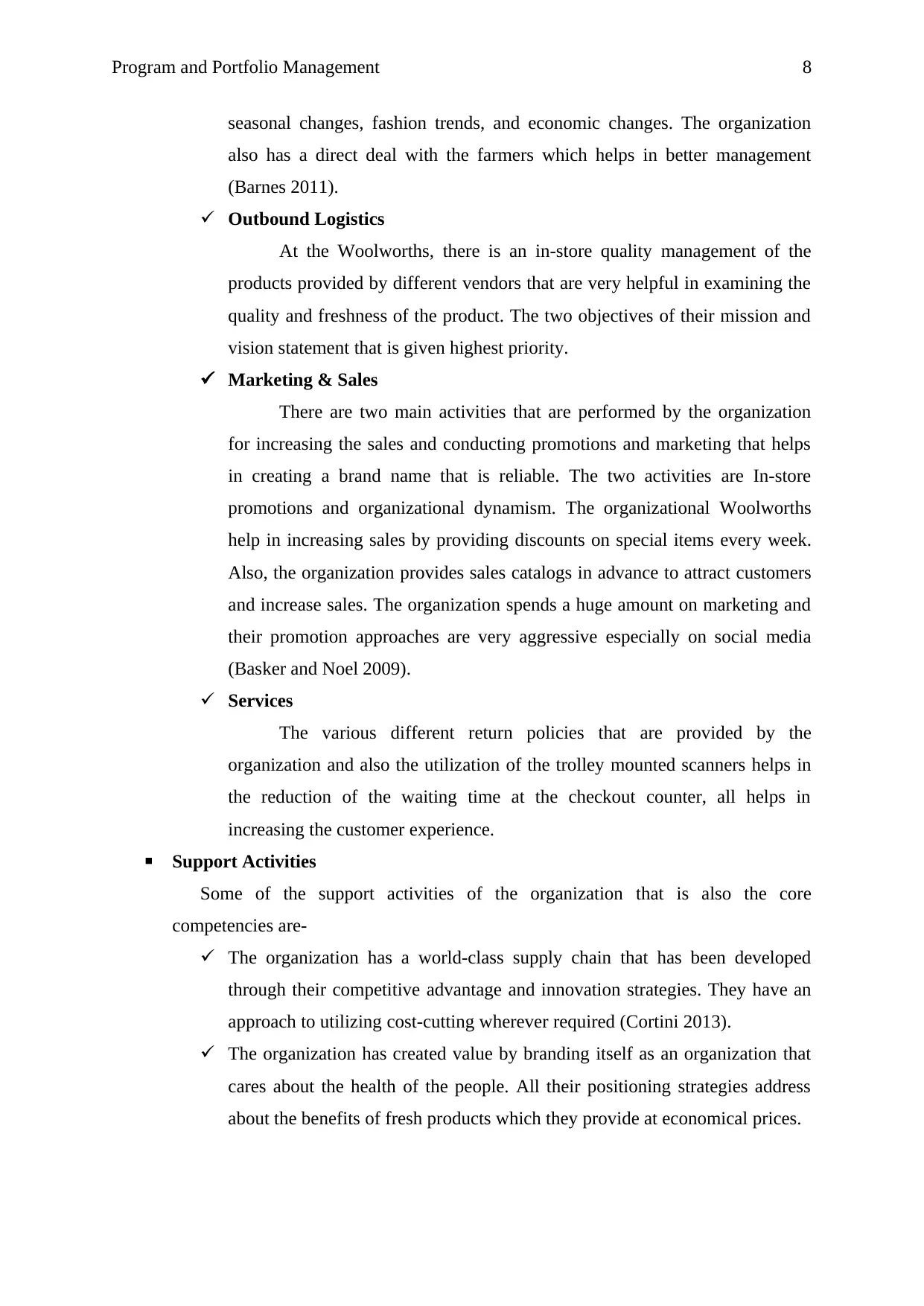
Program and Portfolio Management 8
seasonal changes, fashion trends, and economic changes. The organization
also has a direct deal with the farmers which helps in better management
(Barnes 2011).
Outbound Logistics
At the Woolworths, there is an in-store quality management of the
products provided by different vendors that are very helpful in examining the
quality and freshness of the product. The two objectives of their mission and
vision statement that is given highest priority.
Marketing & Sales
There are two main activities that are performed by the organization
for increasing the sales and conducting promotions and marketing that helps
in creating a brand name that is reliable. The two activities are In-store
promotions and organizational dynamism. The organizational Woolworths
help in increasing sales by providing discounts on special items every week.
Also, the organization provides sales catalogs in advance to attract customers
and increase sales. The organization spends a huge amount on marketing and
their promotion approaches are very aggressive especially on social media
(Basker and Noel 2009).
Services
The various different return policies that are provided by the
organization and also the utilization of the trolley mounted scanners helps in
the reduction of the waiting time at the checkout counter, all helps in
increasing the customer experience.
Support Activities
Some of the support activities of the organization that is also the core
competencies are-
The organization has a world-class supply chain that has been developed
through their competitive advantage and innovation strategies. They have an
approach to utilizing cost-cutting wherever required (Cortini 2013).
The organization has created value by branding itself as an organization that
cares about the health of the people. All their positioning strategies address
about the benefits of fresh products which they provide at economical prices.
seasonal changes, fashion trends, and economic changes. The organization
also has a direct deal with the farmers which helps in better management
(Barnes 2011).
Outbound Logistics
At the Woolworths, there is an in-store quality management of the
products provided by different vendors that are very helpful in examining the
quality and freshness of the product. The two objectives of their mission and
vision statement that is given highest priority.
Marketing & Sales
There are two main activities that are performed by the organization
for increasing the sales and conducting promotions and marketing that helps
in creating a brand name that is reliable. The two activities are In-store
promotions and organizational dynamism. The organizational Woolworths
help in increasing sales by providing discounts on special items every week.
Also, the organization provides sales catalogs in advance to attract customers
and increase sales. The organization spends a huge amount on marketing and
their promotion approaches are very aggressive especially on social media
(Basker and Noel 2009).
Services
The various different return policies that are provided by the
organization and also the utilization of the trolley mounted scanners helps in
the reduction of the waiting time at the checkout counter, all helps in
increasing the customer experience.
Support Activities
Some of the support activities of the organization that is also the core
competencies are-
The organization has a world-class supply chain that has been developed
through their competitive advantage and innovation strategies. They have an
approach to utilizing cost-cutting wherever required (Cortini 2013).
The organization has created value by branding itself as an organization that
cares about the health of the people. All their positioning strategies address
about the benefits of fresh products which they provide at economical prices.
⊘ This is a preview!⊘
Do you want full access?
Subscribe today to unlock all pages.

Trusted by 1+ million students worldwide
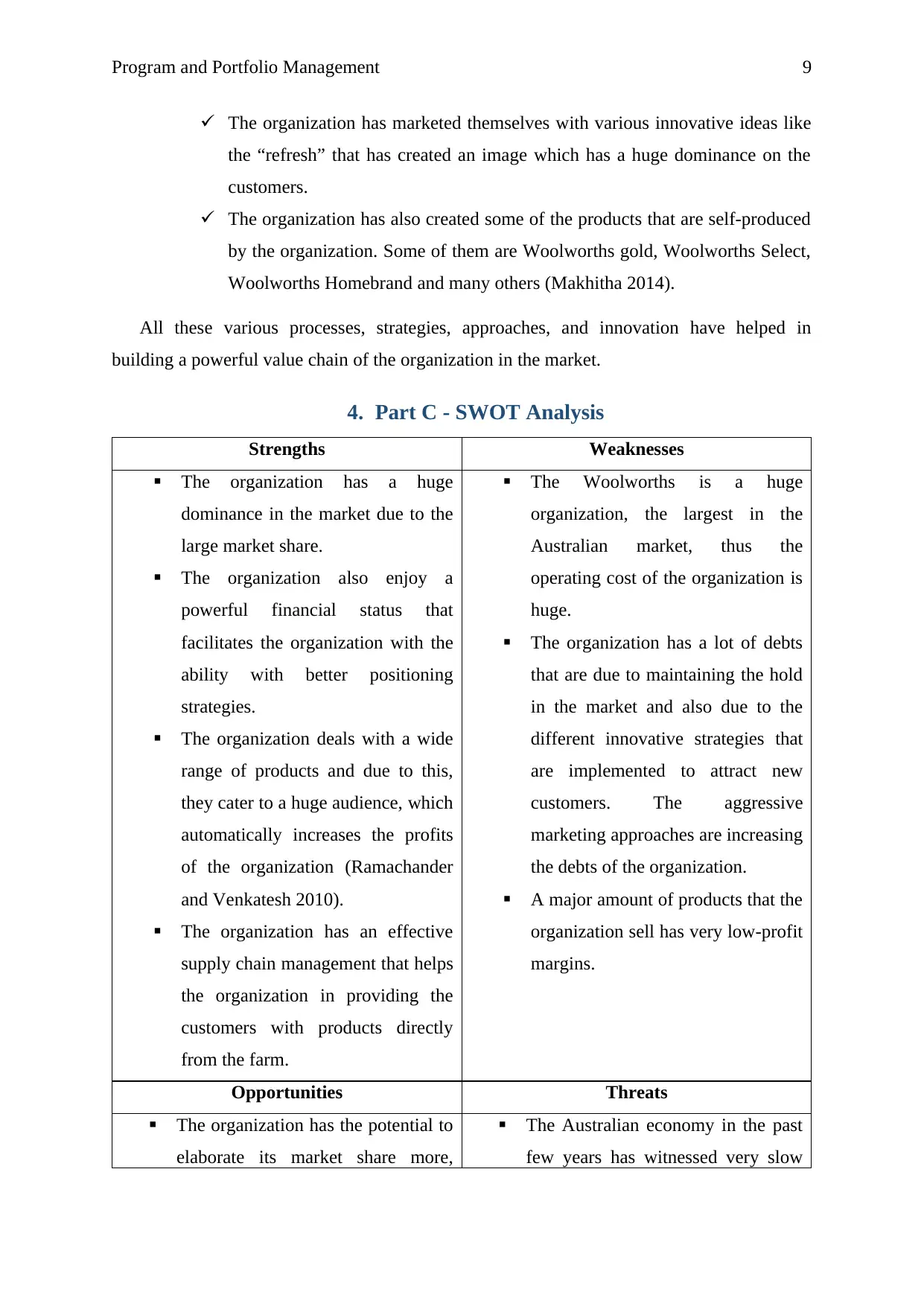
Program and Portfolio Management 9
The organization has marketed themselves with various innovative ideas like
the “refresh” that has created an image which has a huge dominance on the
customers.
The organization has also created some of the products that are self-produced
by the organization. Some of them are Woolworths gold, Woolworths Select,
Woolworths Homebrand and many others (Makhitha 2014).
All these various processes, strategies, approaches, and innovation have helped in
building a powerful value chain of the organization in the market.
4. Part C - SWOT Analysis
Strengths Weaknesses
The organization has a huge
dominance in the market due to the
large market share.
The organization also enjoy a
powerful financial status that
facilitates the organization with the
ability with better positioning
strategies.
The organization deals with a wide
range of products and due to this,
they cater to a huge audience, which
automatically increases the profits
of the organization (Ramachander
and Venkatesh 2010).
The organization has an effective
supply chain management that helps
the organization in providing the
customers with products directly
from the farm.
The Woolworths is a huge
organization, the largest in the
Australian market, thus the
operating cost of the organization is
huge.
The organization has a lot of debts
that are due to maintaining the hold
in the market and also due to the
different innovative strategies that
are implemented to attract new
customers. The aggressive
marketing approaches are increasing
the debts of the organization.
A major amount of products that the
organization sell has very low-profit
margins.
Opportunities Threats
The organization has the potential to
elaborate its market share more,
The Australian economy in the past
few years has witnessed very slow
The organization has marketed themselves with various innovative ideas like
the “refresh” that has created an image which has a huge dominance on the
customers.
The organization has also created some of the products that are self-produced
by the organization. Some of them are Woolworths gold, Woolworths Select,
Woolworths Homebrand and many others (Makhitha 2014).
All these various processes, strategies, approaches, and innovation have helped in
building a powerful value chain of the organization in the market.
4. Part C - SWOT Analysis
Strengths Weaknesses
The organization has a huge
dominance in the market due to the
large market share.
The organization also enjoy a
powerful financial status that
facilitates the organization with the
ability with better positioning
strategies.
The organization deals with a wide
range of products and due to this,
they cater to a huge audience, which
automatically increases the profits
of the organization (Ramachander
and Venkatesh 2010).
The organization has an effective
supply chain management that helps
the organization in providing the
customers with products directly
from the farm.
The Woolworths is a huge
organization, the largest in the
Australian market, thus the
operating cost of the organization is
huge.
The organization has a lot of debts
that are due to maintaining the hold
in the market and also due to the
different innovative strategies that
are implemented to attract new
customers. The aggressive
marketing approaches are increasing
the debts of the organization.
A major amount of products that the
organization sell has very low-profit
margins.
Opportunities Threats
The organization has the potential to
elaborate its market share more,
The Australian economy in the past
few years has witnessed very slow
Paraphrase This Document
Need a fresh take? Get an instant paraphrase of this document with our AI Paraphraser
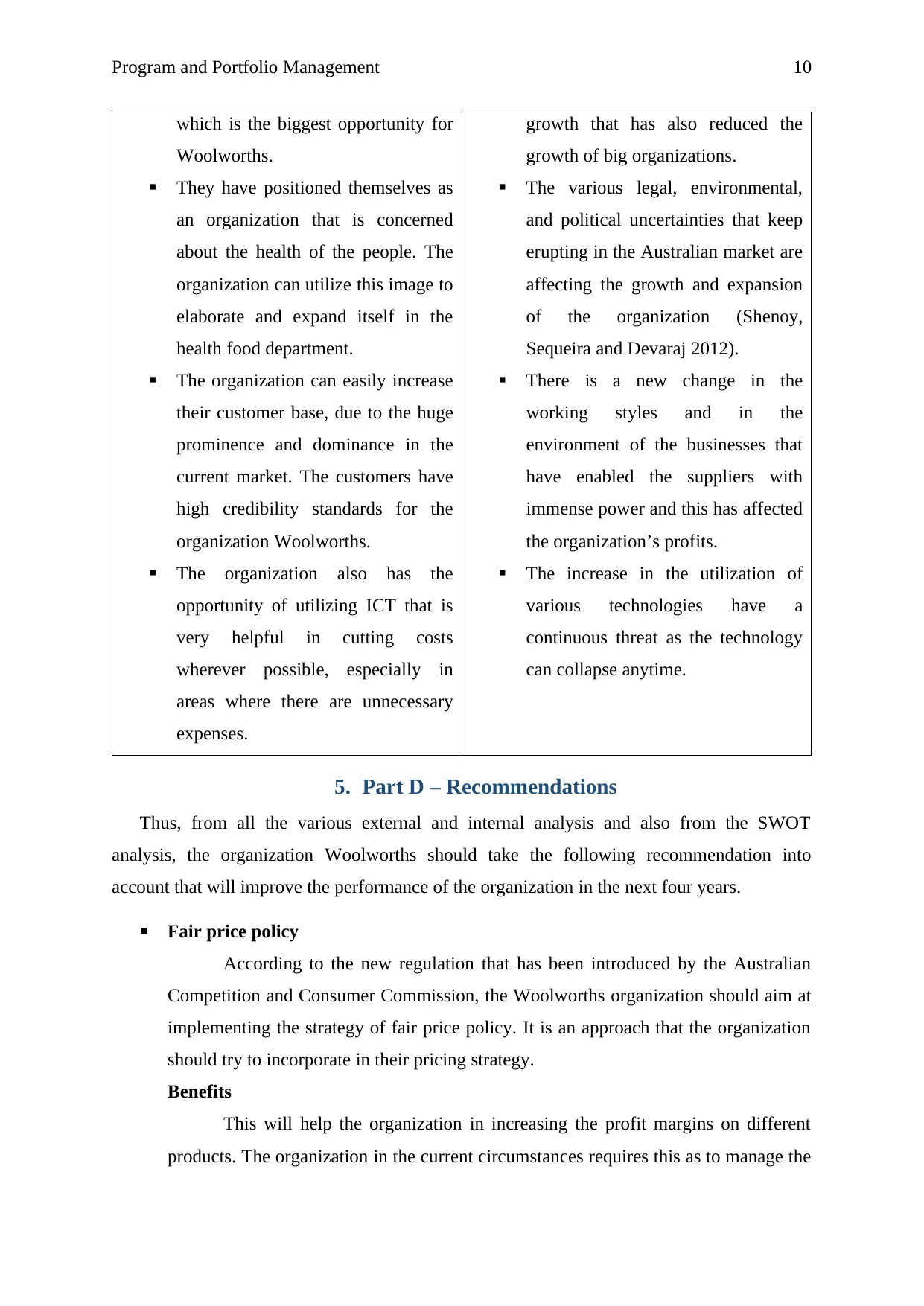
Program and Portfolio Management 10
which is the biggest opportunity for
Woolworths.
They have positioned themselves as
an organization that is concerned
about the health of the people. The
organization can utilize this image to
elaborate and expand itself in the
health food department.
The organization can easily increase
their customer base, due to the huge
prominence and dominance in the
current market. The customers have
high credibility standards for the
organization Woolworths.
The organization also has the
opportunity of utilizing ICT that is
very helpful in cutting costs
wherever possible, especially in
areas where there are unnecessary
expenses.
growth that has also reduced the
growth of big organizations.
The various legal, environmental,
and political uncertainties that keep
erupting in the Australian market are
affecting the growth and expansion
of the organization (Shenoy,
Sequeira and Devaraj 2012).
There is a new change in the
working styles and in the
environment of the businesses that
have enabled the suppliers with
immense power and this has affected
the organization’s profits.
The increase in the utilization of
various technologies have a
continuous threat as the technology
can collapse anytime.
5. Part D – Recommendations
Thus, from all the various external and internal analysis and also from the SWOT
analysis, the organization Woolworths should take the following recommendation into
account that will improve the performance of the organization in the next four years.
Fair price policy
According to the new regulation that has been introduced by the Australian
Competition and Consumer Commission, the Woolworths organization should aim at
implementing the strategy of fair price policy. It is an approach that the organization
should try to incorporate in their pricing strategy.
Benefits
This will help the organization in increasing the profit margins on different
products. The organization in the current circumstances requires this as to manage the
which is the biggest opportunity for
Woolworths.
They have positioned themselves as
an organization that is concerned
about the health of the people. The
organization can utilize this image to
elaborate and expand itself in the
health food department.
The organization can easily increase
their customer base, due to the huge
prominence and dominance in the
current market. The customers have
high credibility standards for the
organization Woolworths.
The organization also has the
opportunity of utilizing ICT that is
very helpful in cutting costs
wherever possible, especially in
areas where there are unnecessary
expenses.
growth that has also reduced the
growth of big organizations.
The various legal, environmental,
and political uncertainties that keep
erupting in the Australian market are
affecting the growth and expansion
of the organization (Shenoy,
Sequeira and Devaraj 2012).
There is a new change in the
working styles and in the
environment of the businesses that
have enabled the suppliers with
immense power and this has affected
the organization’s profits.
The increase in the utilization of
various technologies have a
continuous threat as the technology
can collapse anytime.
5. Part D – Recommendations
Thus, from all the various external and internal analysis and also from the SWOT
analysis, the organization Woolworths should take the following recommendation into
account that will improve the performance of the organization in the next four years.
Fair price policy
According to the new regulation that has been introduced by the Australian
Competition and Consumer Commission, the Woolworths organization should aim at
implementing the strategy of fair price policy. It is an approach that the organization
should try to incorporate in their pricing strategy.
Benefits
This will help the organization in increasing the profit margins on different
products. The organization in the current circumstances requires this as to manage the
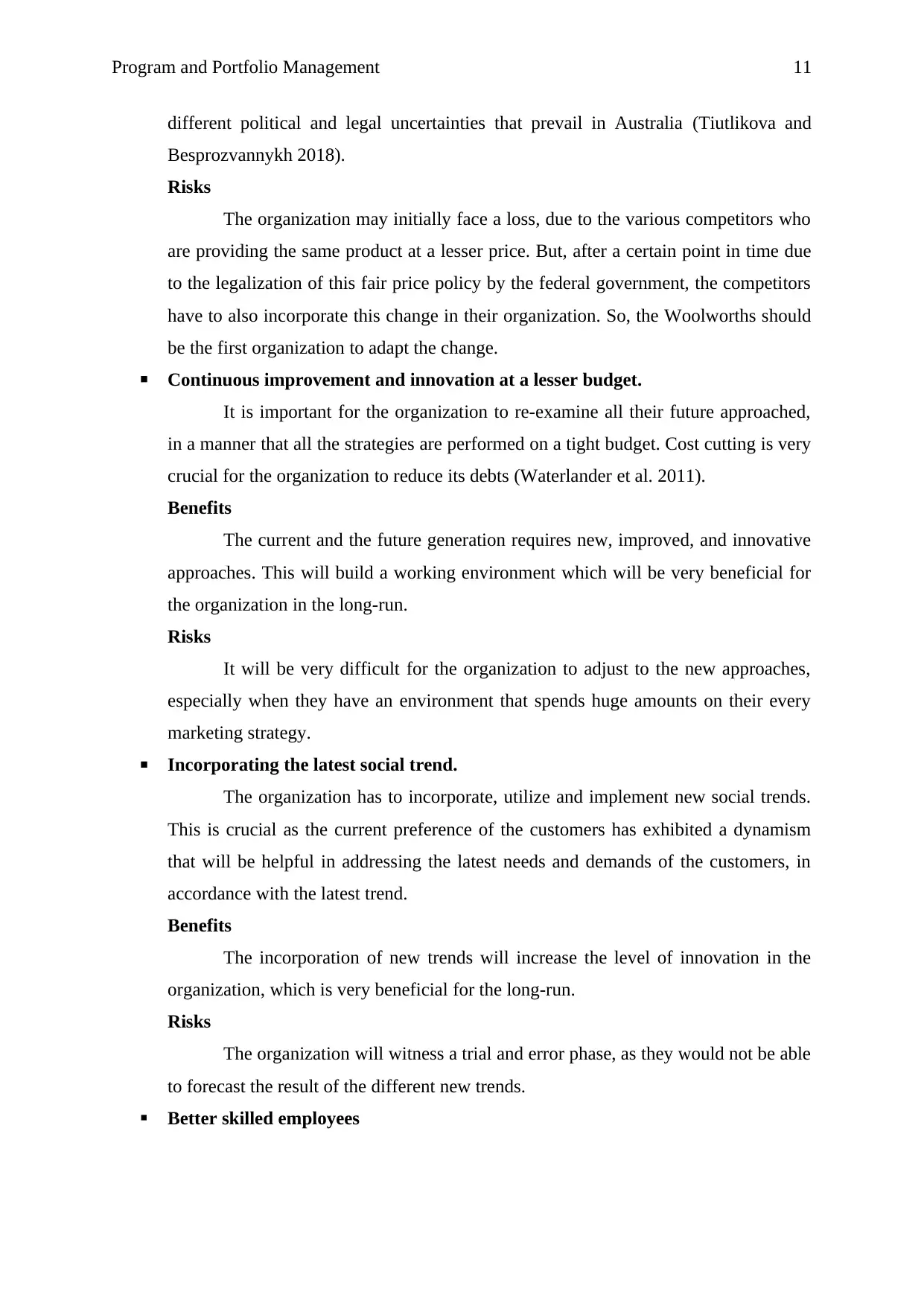
Program and Portfolio Management 11
different political and legal uncertainties that prevail in Australia (Tiutlikova and
Besprozvannykh 2018).
Risks
The organization may initially face a loss, due to the various competitors who
are providing the same product at a lesser price. But, after a certain point in time due
to the legalization of this fair price policy by the federal government, the competitors
have to also incorporate this change in their organization. So, the Woolworths should
be the first organization to adapt the change.
Continuous improvement and innovation at a lesser budget.
It is important for the organization to re-examine all their future approached,
in a manner that all the strategies are performed on a tight budget. Cost cutting is very
crucial for the organization to reduce its debts (Waterlander et al. 2011).
Benefits
The current and the future generation requires new, improved, and innovative
approaches. This will build a working environment which will be very beneficial for
the organization in the long-run.
Risks
It will be very difficult for the organization to adjust to the new approaches,
especially when they have an environment that spends huge amounts on their every
marketing strategy.
Incorporating the latest social trend.
The organization has to incorporate, utilize and implement new social trends.
This is crucial as the current preference of the customers has exhibited a dynamism
that will be helpful in addressing the latest needs and demands of the customers, in
accordance with the latest trend.
Benefits
The incorporation of new trends will increase the level of innovation in the
organization, which is very beneficial for the long-run.
Risks
The organization will witness a trial and error phase, as they would not be able
to forecast the result of the different new trends.
Better skilled employees
different political and legal uncertainties that prevail in Australia (Tiutlikova and
Besprozvannykh 2018).
Risks
The organization may initially face a loss, due to the various competitors who
are providing the same product at a lesser price. But, after a certain point in time due
to the legalization of this fair price policy by the federal government, the competitors
have to also incorporate this change in their organization. So, the Woolworths should
be the first organization to adapt the change.
Continuous improvement and innovation at a lesser budget.
It is important for the organization to re-examine all their future approached,
in a manner that all the strategies are performed on a tight budget. Cost cutting is very
crucial for the organization to reduce its debts (Waterlander et al. 2011).
Benefits
The current and the future generation requires new, improved, and innovative
approaches. This will build a working environment which will be very beneficial for
the organization in the long-run.
Risks
It will be very difficult for the organization to adjust to the new approaches,
especially when they have an environment that spends huge amounts on their every
marketing strategy.
Incorporating the latest social trend.
The organization has to incorporate, utilize and implement new social trends.
This is crucial as the current preference of the customers has exhibited a dynamism
that will be helpful in addressing the latest needs and demands of the customers, in
accordance with the latest trend.
Benefits
The incorporation of new trends will increase the level of innovation in the
organization, which is very beneficial for the long-run.
Risks
The organization will witness a trial and error phase, as they would not be able
to forecast the result of the different new trends.
Better skilled employees
⊘ This is a preview!⊘
Do you want full access?
Subscribe today to unlock all pages.

Trusted by 1+ million students worldwide
1 out of 16
Related Documents
Your All-in-One AI-Powered Toolkit for Academic Success.
+13062052269
info@desklib.com
Available 24*7 on WhatsApp / Email
![[object Object]](/_next/static/media/star-bottom.7253800d.svg)
Unlock your academic potential
Copyright © 2020–2025 A2Z Services. All Rights Reserved. Developed and managed by ZUCOL.




